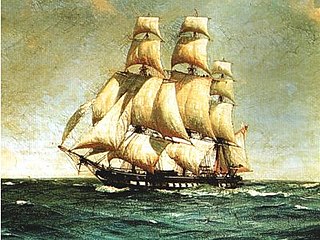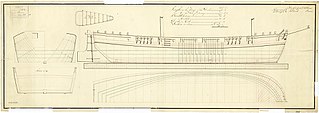Thirteen vessels of the Royal Navy have borne the name HMS Mohawk, after the Mohawk, an indigenous tribe of North America:
Thirteen ships of the Royal Navy have been named HMS Shark after the shark:
Mignonne was an 18-gun Etna-class corvette of the French Navy, launched in 1795. She served until 1803 when the British captured her. Though she served briefly, there is no record of her actually being commissioned into the Royal Navy; she grounded and was condemned in 1804.

The Téméraire-class ships of the line were a class of a hundred and twenty 74-gun ships of the line ordered between 1782 and 1813 for the French navy or its attached navies in dependent (French-occupied) territories. Although a few of these were cancelled, the type was and remains the most numerous class of capital ship ever built to a single design.
Eight ships of the Royal Navy have borne the name HMS Espiegle

HMS Castor was a 32-gun Amazon-class fifth-rate frigate of the Royal Navy. She served during the French Revolutionary and Napoleonic Wars. The French briefly captured her during the Atlantic Campaign of May 1794 but she spent just 20 days in French hands as a British ship retook her before her prize crew could reach a French port. Castor eventually saw service in many of the theatres of the wars, spending time in the waters off the British Isles, in the Mediterranean and Atlantic, as well as the Caribbean.

The Seine class was a class of four 42-gun frigates of the French Navy, designed in 1793 by Pierre-Alexandre Forfait. A fifth vessel, Furieuse, was originally ordered at Cherbourg in February 1794 to Forfait's Romaine-class design, but was instead completed to the design of the Seine class.
The first HMS Epervier, sometimes spelled HMS Epervoir, was the French ex-naval brick-aviso and then privateer Épervier, launched in 1788. The British captured her in 1797 and registered her in 1798 as an 18-gun brig-sloop of the Royal Navy. The Navy never commissioned her and she was sold in 1801.

HMS Decade was a 36-gun fifth-rate frigate of the Royal Navy. She was formerly the French ' Galathée-class frigateDécade, which the British had captured in 1798. She served with the British during the French Revolutionary and Napoleonic Wars, and was sold out of the service in 1811.
HMS Swift has been the name of numerous ships of the Royal Navy:

The Speedy class brigs were a two-ship class of brig built for the Royal Navy during the later years of the American War of Independence. They survived into the French Revolutionary Wars.

Alceste was a Magicienne class frigate of the French Navy, launched in 1780, that the British seized at the Siege of Toulon. They transferred her to the Kingdom of Sardinia, but the French recaptured her a year later in the action of 8 June 1794. The British captured her again at the action of 18 June 1799 and took her into service as HMS Alceste. In 1801 she became a floating battery and she was sold the next year.

Cruelle was a schooner-cannoniere (gun-schooner), launched in 1793. The British captured her in June 1800 and commissioned her as HMS Cruelle. She spent a little over a year in the Mediterranean, serving at Malta and Alexandria before the Royal Navy sold her in 1801.
The Musquito class was a Royal Navy class of two 4-gun floating batteries built to a design by Admiral Sir Sidney Smith specifically to serve with his squadron in French coastal waters. Both were named and ordered under Admiralty Order 26 May 1794.
The Etna class was a class of six 16 or 18-gun corvettes with a flat hull, designed by Pierre-Alexandre-Laurent Forfait and his pupil Charles-Henri Tellier. Four separate commercial shipbuilders were involved in their construction by contract - including André-François Normand, Courtois and Denise at Honfleur, and Fouache at Le Havre, while the sixth vessel was built by Pierre Ozanne at Cherbourg Dockyard. The vessels were flush-decked and originally designed to carry a 12-inch mortar. However, as the British navy captured Etna within a year and a half of her launch at which time she was not carrying any mortar, it is possible that the design was modified quite early to delete the mortar.
The Minerve class was a type of 40-gun frigate of the French Navy, carrying 18-pounder long guns as their main armament. Six ships of this type were built at Toulon Dockyard, and launched between 1782 and 1794. The frigates served the French Navy briefly during the French Revolutionary Wars. The Royal Navy captured all six between 1793 and 1799 and took them into service, with all but one serving in the Napoleonic Wars, and some thereafter.
HMS Bravo was a 16-gun Firm-class floating battery of the Royal Navy, launched in 1794. The two-vessel class was intended to operate in shallow waters. Bravo spent her brief, uneventful service life as the flagship for Commodore Philippe d'Auvergne's flotilla at Jersey. After the Peace of Amiens Bravo was paid off in March 1802; she was sold in 1803.

HMS Firm was a 16-gun Firm-class floating battery of the Royal Navy, launched in 1794. The two-vessel class was intended to operate in shallow waters. After the Peace of Amiens Firm was paid off in March 1802; she was sold in 1803.

HMS Eclipse was a French Navy Vésuve-class brick-canonnier or chaloupe-canonnière, (gunbrig) launched at Saint-Malo in 1793 as Volage. She was renamed Venteux in 1795 (possibly also Vérité on 30 May 1795, although this might have been a second ship of the same name. The British Royal Navy captured her in 1803 and took her into service as HMS Eagle, but then renamed her HMS Eclipse in 1804. She had a completely unremarkable career before the Navy sold her in 1807.

The Vésuve class was a class of seven 4-gun gunbrigs (bricks-canonniers).







